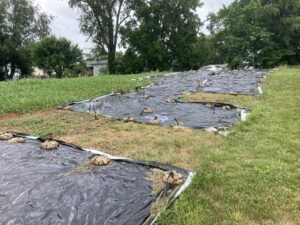ROANOKE, Virginia – Farmers have long understood that tarping plots prior to planting can kill weeds, but how long it took for weeds to die under cover wasn’t completely known. Baseline research conducted by Virginia Cooperative Extension is providing some specifics.
Funded by a Southern Sustainable Agriculture Research and Education (SSARE) On-Farm Research Grant, Virginia Tech Agriculture and Natural Resources Extension Agent Shawn Jadrnicek covered 24 10’X10’ plots with light blocking silage tarps over a 16-week period between May and September to determine the amount of time required to kill a variety of annual and perennial weeds.
Results showed that while some weeds took longer than other weed species to die off under cover, the tarping time to achieve weed die-off was cut in half compared to farmers’ previous experiences.
“Farmers were previously tarping areas for an entire year, and with this research, we now know that perennial weeds can be killed in half of the growing season, allowing the other half to be dedicated to production or cover cropping increasing productivity or soil building,” Jadrnicek observed in the research final report.
A Virginia Cooperative Extension factsheet, “Tarping and Occultation Techniques in Gardening and Farming,” was developed highlighting the research, along with a handy table showing the timeframe required to kill weeds. Over 30 annual and perennial weed species were showcased, such as crabgrass, curly dock, dandelion, pigweed, purple violet, speedwell, vetch, wild garlic, and yellow woodsorrel.
The research assessed that the silage tarps killed some weeds, such as black medic, buff petal, Carolina geranium, and purple deadnettle in a short period of time (2-4 weeks); others were tougher to control, such as bermudagrass and johnsongrass taking 14-16 weeks under cover. Nutsedge, mugwort, dandelion and wild garlic persisted after 16 weeks under cover.
Jadrnicek said that edge effect on the tarps might have played a role in weed persistence. “If a neighboring tarp was uncovered, potentially a perennial weed in an adjacent plot that was still covered could have been reinvigorated by the exposure of sunlight in the uncovered plot,” he noted in the report.
The information collected from the research may be an invaluable tool to help farmers apply tarps during specific timeframes to better control weeds of concern, allowing them to return land to production sooner and maximize productivity.
